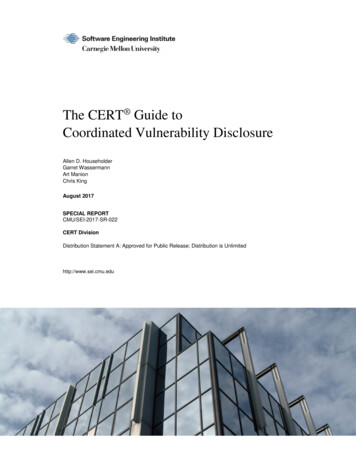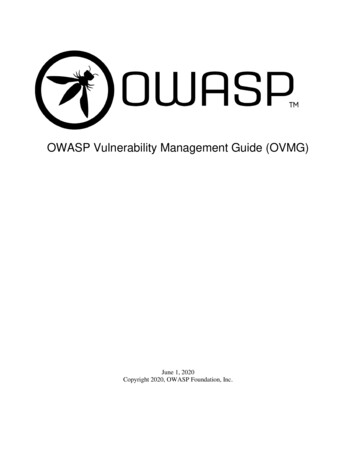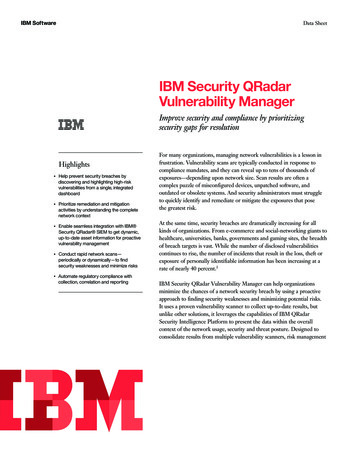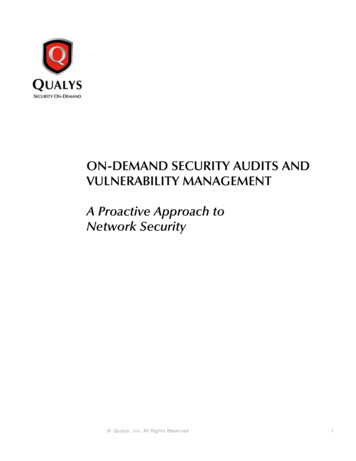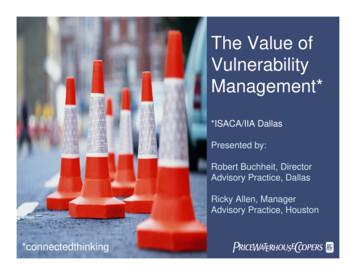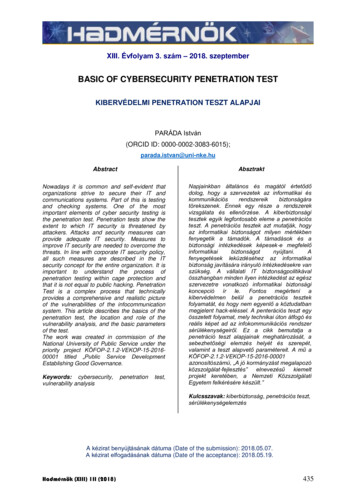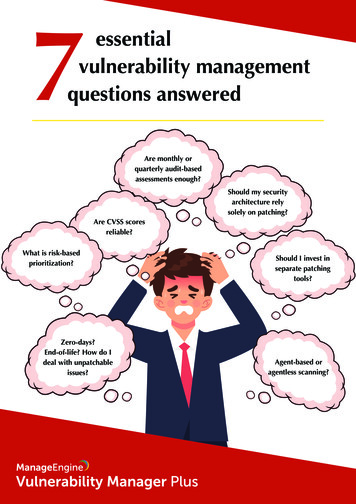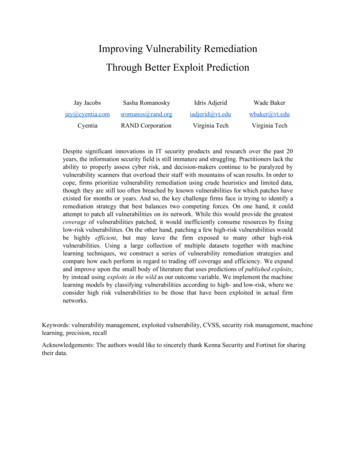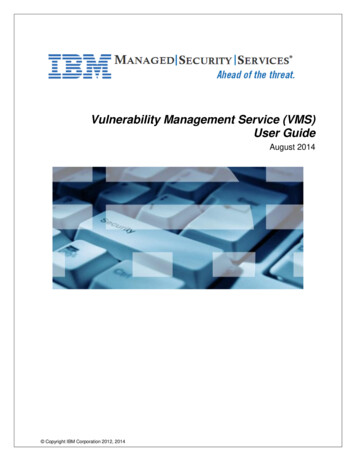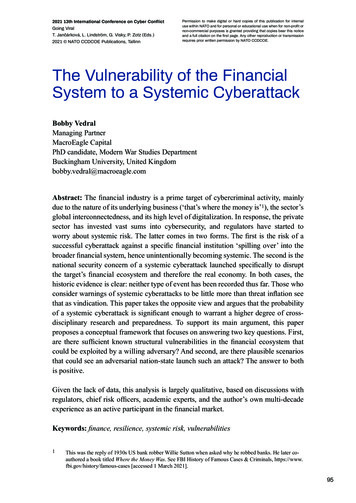
Transcription
2021 13th International Conference on Cyber ConflictGoing ViralT. Jančárková, L. Lindström, G. Visky, P. Zotz (Eds.)2021 NATO CCDCOE Publications, TallinnPermission to make digital or hard copies of this publication for internaluse within NATO and for personal or educational use when for non-profit ornon-commercial purposes is granted providing that copies bear this noticeand a full citation on the first page. Any other reproduction or transmissionrequires prior written permission by NATO CCDCOE.The Vulnerability of the FinancialSystem to a Systemic CyberattackBobby VedralManaging PartnerMacroEagle CapitalPhD candidate, Modern War Studies DepartmentBuckingham University, United Kingdombobby.vedral@macroeagle.comAbstract: The financial industry is a prime target of cybercriminal activity, mainlydue to the nature of its underlying business (‘that’s where the money is’1), the sector’sglobal interconnectedness, and its high level of digitalization. In response, the privatesector has invested vast sums into cybersecurity, and regulators have started toworry about systemic risk. The latter comes in two forms. The first is the risk of asuccessful cyberattack against a specific financial institution ‘spilling over’ into thebroader financial system, hence unintentionally becoming systemic. The second is thenational security concern of a systemic cyberattack launched specifically to disruptthe target’s financial ecosystem and therefore the real economy. In both cases, thehistoric evidence is clear: neither type of event has been recorded thus far. Those whoconsider warnings of systemic cyberattacks to be little more than threat inflation seethat as vindication. This paper takes the opposite view and argues that the probabilityof a systemic cyberattack is significant enough to warrant a higher degree of crossdisciplinary research and preparedness. To support its main argument, this paperproposes a conceptual framework that focuses on answering two key questions. First,are there sufficient known structural vulnerabilities in the financial ecosystem thatcould be exploited by a willing adversary? And second, are there plausible scenariosthat could see an adversarial nation-state launch such an attack? The answer to bothis positive.Given the lack of data, this analysis is largely qualitative, based on discussions withregulators, chief risk officers, academic experts, and the author’s own multi-decadeexperience as an active participant in the financial market.Keywords: finance, resilience, systemic risk, vulnerabilities1This was the reply of 1930s US bank robber Willie Sutton when asked why he robbed banks. He later coauthored a book titled Where the Money Was. See FBI History of Famous Cases & Criminals, https://www.fbi.gov/history/famous-cases [accessed 1 March 2021].95
1. INTRODUCTIONThe global financial system lies at the heart of Western liberal democratic marketeconomies, performing many key intermediary functions, such as deposit-taking,lending, capital markets, investments, and payments. As it is at the forefront ofglobalization, interconnectedness, and digitalization, its reliance on the confidentiality,integrity, and availability of data and systems is mission critical. It is thereforeno surprise that national security experts have long predicted the possibility of acyberattack on the financial system with systemic consequences, one where stateswould ‘suffer greatly from the instability which would befall world markets shouldnumbers be shifted in bank accounts and data wiped from international financialservers’.2‘Systemic cyber risk’ therefore means a risk of disruption in the financial systemwith the potential of serious negative consequences for the real economy. This paperdifferentiates between two types of systemic cyber risks (see Figure 1). The first isone that starts as an idiosyncratic (company-specific) cyberattack, most probably withcriminal intent but not intent to cause system-wide damage, but which inadvertentlyspills over to the wider financial system. This tends to be the main concern of financialregulators, given that empirical evidence points to cybercrime as the main risk. Thesecond is the ‘systemic attack’, defined as a nation-state or transnational group actingwith the political intent to cause severe financial instability in the target’s financialmarkets and thus harm the real economy as well. This tends to be the main concernof the national security establishment and is the main focus of this essay. In addition,this paper defines ‘cyberattack’ as an event-risk/shock and not as the long-termundermining of an industry through espionage (‘slow burn’ or ‘death by a thousandcuts’).32396Jordan Schneider, as quoted in P.W. Singer and Allan Friedman, Cybersecurity and Cyberwar: WhatEveryone Needs to Know (Oxford: Oxford University Press, 2014), 191.Jason Healey et al., for example, differentiate between three types of crises: slow burn (long-termundermining), exacerbated crisis (when a financial crisis is already in progress), and initiated crisis(when an adversary uses cyber capabilities to create a financial crisis). See Jason Healey, Patricia Moser,Katheryn Rosen, and Adriana Tache, ‘The Future of Financial Stability and Cyber Risk’, BrookingsInstitution, October 2018, 10/Healey-et-al FinancialStability-and-Cyber-Risk.pdf.
FIGURE 1: SYSTEMIC CRISIS BY SPILLOVER VS BY INTENTThe quantitative evidence regarding systemic cyberattacks is clear: neither a ‘systemicspillover’ nor a ‘systemic attack’ have occurred so far. But, as Figure 2 highlights, thefinancial sector ranks first in most studies when it comes to the frequency of cyberincidents, with most of them idiosyncratic (company specific) and criminal in nature.Also noticeable is that, probably due to the industry’s high level of investment incybersecurity, the average cost per incident is low.4FIGURE 2: CROSS-SECTOR ANALYSIS OF CYBER INCIDENT FREQUENCY AND LOSSES5Frequency ofincidents(% of total)Total loss(% of total)Finance &insurance24%Most exposedsectorFinance(24%)CategoryMean lossin USD(%ile)Standarddeviation of lossin USD (%ile)16%USD 1.69 m(10th %ile)USD 15.45 m(13th %ile)Professional,scientific, technicalUSD 8,778 m(22%)Transportationand storageUSD 16.8 m(100th %ile)Wholesale tradeUSD 120.6 m(100th %ile)This lack of systemic attacks can be attributed to three factors. First, even criminalnation-state actors, such as North Korea, need the capitalist financial system to workin order to cash out. Second, even strategic rivals, like China, need Western capitalistresources to fund their own growth; hence they have no interest in ‘biting the handthat feeds them’. And third, systemic attacks on less well guarded critical nationalinfrastructures (CNIs) may be easier to execute.45An excellent database for cyber incidents in the financial sector is kept by the Carnegie Endowment’s‘Timeline of Cyber Incidents Involving Financial Institutions’, ectingfinancialstability/timeline [accessed 5 January 2021].For a recent global cross-sector study of cyber incidents in terms of frequencies and losses, see IñakiAldasoro, Leonardo Gambacorta, Paolo Giudici, and Thomas Leach, The Drivers of Cyber Risk, Bank ofInternational Settlements (BIS), Working Paper No 865, May 2020, https://www.bis.org/publ/work865.htm. All loss data are in millions of US dollars (USD). Twenty sectors and 115,415 incidents areconsidered.97
Why, then, worry about a systemic cyberattack on the financial system? To answer thisquestion, this paper suggests a conceptual framework which defines the probabilityadjusted economic cost (PAEC) of such an event as a function of the expectedeconomic cost (EEC) should it occur, times the probability of such a systemiccyberattack succeeding, i.e., the probability of a successful attack (PSA). The PSA inturn is a function of: (1) the number of structural vulnerabilities in the financial systemthat could be exploited; (2) the probability that an adversary has the technical abilityto exploit them; (3) the probability that an adversary has the political intent to launchsuch an attack.𝑃𝐴𝐸𝐶 𝐸𝐸𝐶 x 𝑃𝑆𝐴 (vulnerabilities,ability,intent)Based on various conversations with financial regulators and practitioners, manyagree that the key parameter in this model is ‘intent’. As Tim Maurer writes, ‘the mainvariable determining whether an actor can cause harm is not technical sophistication,not knowledge of specific vulnerabilities or development of sophisticated codes,but intent. If the intent is there, the capability will follow’.6 Backed by the abovementioned absence of precedent for historic systemic attacks, many practitionerspoint to the lack of intent as the main reason. As a chief information security officerat a major European bank wrote:[ ] the Chinese have zero interest in doing anything destructive to usor any other member of a financial system that makes them wealthy andallows them to wield political and economic influence abroad. Even Iranwas circumspect in 2013 when they DDOSed US banks – the attack techwas pretty considerable, but the targets (retail banking websites) were fairlytrivial. As long as GDP is a meaningful indicator to a nation-state, I don’tbelieve that nation-state would perpetrate systemic attacks. That said, I’msure they’re curious what their rich citizens are up to, especially if thatwealth could be used to aid the opposition, so it wouldn’t surprise me ifnation-states use espionage tactics against banks. But I can’t get my headaround any country just wanting to watch the system burn – even NorthKorea, now that they’ve discovered how to raise hard currency throughhacking.7Hence the focus of this paper is to make the case that the probability of a systemicattack is neither ‘zero’ nor ‘very low’, as the historical precedent and consensus view,respectively, imply. The argument is developed in five parts. Section 2 reviews theexisting literature on systemic risk in the financial system, which broadly agrees withthe assessment that the impact of such an event would be significant and that the6798Tim Maurer, Cyber Mercenaries: The State, Hackers, and Power (Cambridge: Cambridge UniversityPress, 2018), 10.Chief Information Security Officer (CISO) of major Western bank, email to author, 22 December 2020.
probability is not zero. Section 3 makes the point that sufficient known vulnerabilitiesin the current financial ecosystem exist that could be exploited if the will to do sowere there. Section 4 addresses the key question about political intent from variousperspectives, including historical, cultural, and doctrinal. Section 5 concludes withsome basic recommendations and suggestions for further research.2. LITERATURE REVIEW ON ‘SYSTEMIC CYBER RISK’TO THE FINANCIAL SYSTEMInterest in ‘systemic risk’ took off after the Great Financial Crisis (GFC) of 2007–2008,although the focus was always more on quantifiable financial aspects, such as market,credit, and liquidity risk. Cyber risk, a sub-category of operational risk, receivedrelatively little attention. With no commonly accepted definition of systemic risk, by2009 the Financial Stability Board (FSB) outlined three criteria: size, substitutability,and interconnectedness.8By 2013, and following the Stuxnet disclosures, the White House issued ExecutiveOrder 13636, instructing the Department of Homeland Security (DHS) to identifythose financial institutions for which a ‘cyber incident would have far reaching impacton regional or national economic security’.9 This led three years later to the creationof the Financial Systemic Analysis & Resilience Centre (FSARC), one of the firstcollaborative efforts in the private sector.Judging by the Bank of England’s (BOE) semi-annual Systemic Risk Survey (seeFigure 3), ‘cyberattacks’ started to become prominent among financial risk practitionersin 2014, after the cyberattack on JP Morgan. This attack, widely attributed to Iran,affected over 83 million customers.108910Financial Stability Board (FSB), ‘Guidance to Assess the Systemic Importance of Financial Institutions,Markets and Instruments: Initial Considerations’, IMF-BIS-FSB, October 2009, https://www.fsb.org/wpcontent/uploads/r 091107d.pdf.US Government, Executive Order No. 13636, 3 C.F.R. 13636 (2013), as mentioned in Jason Healey et al.,‘The Future of Financial Stability and Cyber Risk’.See, for example, Reuters, ‘JP Morgan Hack Exposed Data of 83 Million, Among Biggest Breachesin History’, 3 October 2014, 03.99
FIGURE 3: BOE SYSTEMIC RISK SURVEY – SOURCES OF RISK TO THE UK FINANCIAL SYSTEM11In 2016, the year North Korea attempted to steal USD 951 million from Bangladesh’scentral bank,12 the members of the G7 released the G7’s Fundamental Elementsof Cybersecurity for the Financial Sector, suggesting eight elements to follow indesigning and implementing a cybersecurity program.13 Although few academics bythat time challenged the view that cyberattacks posed a systemic risk, one importantexception was a 2016 Vox article by Danielsson et al. The article claimed that systemiccyber crises were extremely unlikely, as most cyberattacks were micro-prudential(company-specific) in nature and required extremely fortunate timing to becomesystemic.14In 2017, the year of the WannaCry ransomware attack and Equifax hack, theInternational Monetary Fund (IMF) published a paper describing cyber risk as atextbook example of systemic financial stability risk and identified the main sourcesof vulnerabilities as access, concentration risk, correlation risk, and contagion risk.15Furthermore, the Institute of International Finance (IIF) published a paper that focusedon the main types of scenarios that could have systemic repercussions, such as attacks1112131415100Bank of England (BOE), ‘Systemic Risk Survey Results’, 2015 H2, ey/2015/2015-h2; and 2019 H2, y/2019/2019-h2. Note: Respondents were asked which five risks they believed would have thegreatest impact on the UK financial system if they were to materialize. Answers were provided in freeformat and subsequently coded into the above categories by the BOE.Jim Finkle, ‘Cyber Security Firm: More Evidence North Korea Linked to Bangladesh Heist’, Reuters,3 April 2017, gladesh-northkorea-idUSKBN1752I4[accessed 20 December 2020].G7, ‘G7 Fundamental Elements of Cybersecurity for the Financial Sector’, 11 October 2016, -2016.html [accessed 20 December 2020].Jon Danielsson, Morgan Fouche, and Robert Macrae, ‘Cyber Risk as Systemic Risk’, Vox, 10 June -risk.Emanuel Kopp, Lincoln Kaffenberger, and Christoph Wilson, ‘Cyber Risk, Market Failures, and FinancialStability’, International Monetary Fund (IMF) Working paper No. 17/185, 7 August 2017, ability-45104.
on FMI, data corruption, failure of wider infrastructure, and loss of confidence.16Finally, the US Office of Financial Research (OFR) identified the three key financialstability risks posed by cyberattacks: lack of substitutability, loss of confidence, andloss of data integrity.17By 2018 the BOE published two important papers. One warned that ‘just becausethere has not been a clear example of a systemic impact on the sector yet, it doesnot mean it cannot or will not happen in the future’.18 The second indicated a newand innovative regulatory approach in which the BOE considered the managementof operational resilience to be most effectively addressed by focusing on businessservices rather than on systems and processes. It also announced a new regime ofcloser cooperation with the security services, as the lack of data required it to relymore on expert judgements.19The same year also saw the publication of a widely cited Brookings paper by JasonHealey et al. identifying the three main differences between cyber and financialshocks (timing, complexity, and adversary intent) and flagging four major concerns:attacker sophistication, single points of failure, international coordination, and newtechnologies.20Finally, that year the FSB published a ‘cyber lexicon’ to establish a common languageand ensure consistent data collection and reliable measurement.21 This was followedin 2019 by the International Organization of Securities Commissions (IOSCO)publishing an overview of existing frameworks for cyber regulation to serve asguidance for good practise.22In 2020 the European Systemic Risk Board (ESRB) published two important andrelated papers, both with substantial input from the BOE. The first paper presentsa conceptual model that analyses a cyber incident in four distinct phases: context,16171819202122Martin Boer and Jaime Vazquez, ‘Cyber Security and Financial Stability: How Cyber-Attacks CouldMaterially Impact the Global Financial System’, Institute of International Finance (IIF), September 07%202017.pdf?ver%3D2019-02-19-150125-767.Office of Financial Research (OFR), ‘Cybersecurity and Financial Stability: Risks and Resilience’,OFR Viewpoint 17-01, 15 February 2017, /files/OFRvp 17-01 Cybersecurity.pdf.Phil Warren, Kim Kaivanto, and Dan Prince, ‘Could a Cyber-Attack Cause a Systemic Impact in theFinancial Sector?’ Bank of England (BOE), Quarterly Bulletin, Q4 2018, -a-systemic-impact-final-web.pdf?la en&hash 61555F2E3C15AD6B65E845C13238733B9364D4F6.Bank of England (BOE), ‘Building the UK Financial Sector’s Operational Resilience’, Discussion Paper,BOE-PRA-FCA, July 2018, pdf.Healey et al., ‘The Future of Financial Stability and Cyber Risk’.Financial Stability Board (FSB), ‘Cyber Lexicon’, 12 November 2018, ional Organization of Securities Commissions (IOSCO), ‘Cyber Task Force – Final Report’, June2019, 33.pdf.101
shock, amplification, and systemic event. It then uses the model and discusses threehypothetical scenarios: (1) the incapacitation of a large domestic bank’s paymentsystem; (2) the malicious destruction of account balance data; (3) the scramblingof price and position data.23 In the second paper, the same model is reviewed andan extensive number of systemic mitigants are listed.24 In December, the CarnegieEndowment published a report on systemic cyber risk, identifying and providingdetailed recommendations for six priority areas: cyber resilience, internationalnorms, collective response, workforce challenges, capacity-building, and digitaltransformation.25In summary, the existing literature shows that systemic cyber risk is a concern forfinancial regulators, especially those in Britain and the US, where most of the relevantpublications originate from. It is also noticeable that the concern is fairly recent; mostof the more in-depth studies have been produced over the last one or two years. Thecurrent paper aims to build on the existing literature in that it focuses specifically onthe likelihood of a systemic attack launched by an adversarial nation-state with theintent to disrupt the target financial system. To address this question, this paper willnow turn towards highlighting a number of structural vulnerabilities in the globalfinancial system that could be exploited as either a target or an amplifier during suchan attack. This goes back to this paper’s conceptual model: that the probability ofsuccess is conditioned in part on the availability of vulnerabilities to exploit.3. STRUCTURAL VULNERABILITIESIN THE FINANCIAL ECOSYSTEMThis section provides an overview of 10 known structural vulnerabilities of thefinancial ecosystem that highlight liberal democracies’ higher exposure to financialinstability due to differences in their respective political economies (openness,values), structural concentration risks (currency, geography, counterparty, participants,strategy) or amplification channels (technology, trust) across the system. The listis not meant to be exhaustive or an in-depth analysis of any one vulnerability. Theintention is to highlight the fact that there is no shortage of them and that the numberof possible vulnerabilities is, if anything, a parameter that increases the PSA factor inthe conceptual model.232425102European Systemic Risk Board (ESRB), ‘Systemic Cyber Risk’, February 2020, port200219 systemiccyberrisk 101a09685e.en.pdf.Greg Ros et al., ‘The Making of a Cyber Crash: A Conceptual Model for Systemic Risk in the FinancialSector’, European Systemic Risk Board (ESRB), Occasional Paper Series, No 16, May 2020, .op16 f80ad1d83a.en.pdf.Tim Maurer and Arthur Nelson, ‘International Strategy to Better Protect the Financial System againstCyber Threats’, Carnegie Endowment for International Peace, 2020, https://carnegieendowment.org/files/Maurer Nelson FinCyber final1.pdf.
1 – Degree of financial openness. Figure 4 compares four autocratic regimes withthe main Western financial centres (US, UK) and ranks them based on military andsocioeconomic criteria. Although autocratic states differ greatly in terms of economicsize, they show a much tighter control over their media and financial systems, whichsuggests a greater degree of control in times of crisis. For example, although Chinahas the four largest banks by assets in the world, their international expansion isminimal.26 This contrasts with their American and European peers, who have extensiveinternational networks. Or take North Korea, which has a record of attempting toparalyse financial networks in South Korea through cyberattacks, but whose ownfinancial system is largely analogue and hence immune.27FIGURE 4: KNOW YOUR ADVERSARY (COUNTRY’S GLOBAL RANKING BY enness32(2018)USUK131618453511ChinaRussiaIranNorth Korea24231621129no data2418no data17714917318010585165no data2 – Domestic politics. Given the international exposure of Western financialinstitutions, it is likely that they are more vulnerable to political pressure generated bydomestic conflicts, such as when consumer activism at home clashes with commercialinterests overseas. For example, Beijing’s 2020 imposition of a new security law inHong Kong saw the British government lead the international condemnation, whileHSBC and Standard Chartered, two British banks with significant commercial26272829303132Ali Zarmina, ‘The World’s Largest 100 Banks, 2020’, S&P Global Market Intelligence, 7 April 100largest-banks-2020-57854079.As mentioned in Kong Ji Young, Lim Jong In, and Kim Kyoung Gon, ‘The All-Purpose Sword: NorthKorea’s Cyber Operations and Strategies’, 11th International Conference on Cyber Conflict: Silent Battle(Tallinn: NATO CCDCOE, 2019), 151.Belfer Center, ‘National Cyber Power Index 2020’, Harvard Kennedy School, September 2020, 020-09/NCPI 2020.pdf.GDP data from ‘World Development Indicators’ databank, World Bank, pment-indicators [accessed 30 December 2020].Stockholm International Peace Research Institute (SIPRI), ‘Trends in World Military Expenditure’, April2020, fs 2020 04 milex 0 0.pdf. Military spendingmeasured in billions of US dollars.Reporters Without Borders (RSF), ‘2020 World Press Freedom Index’ dataset, https://rsf.org/en/ranking[accessed 20 December 2020].The Chinn-Ito Financial Openness Index (KAOPEN) is an index measuring a country’s degree of capitalaccount openness and has been updated to 2018. The reference paper is Menzie D. Chinn and Hiro Ito,‘What Matters for Financial Development? Capital Controls, Institutions, and Interactions’, Journal ofDevelopment Economics 81, no. 1 (October 2006): 163–192. The dataset is available under http://web.pdx.edu/ ito/Readme kaopen2018.pdf.103
interests in China, publicly endorsed the new law.33 The point here is not to judge ifWestern institutions should have these conflicts but to highlight that they exist and toencourage further research into their implications.3 – Currency concentration. Figure 5 provides a snapshot of the currency market,where USD 6.6 trillion is traded every day.34 The US dollar is strongly overrepresented(when compared to US GDP), while the Chinese yuan is strongly underrepresented(when compared to China’s GDP). While in the short term, this may seem to conferan advantage on the US – for instance, to be able to apply economic sanctions oncountries such as Russia and Iran – there are three drawbacks. First, any loss ofconfidence in the US dollar would immediately have systemic repercussions. Second,the sanctions have driven Russia and China to develop their own parallel financialinfrastructure, which will increase their operational independence and resilience inthe future.35 Third, a country falling under US dollar sanctions is so cut off from theglobal financial system that it might consider there to be no downside in attacking thesystem.FIGURE 5: US DOLLAR HEGEMONY IN THE FINANCIAL SYSTEM% GDP (2019)36Daily currency turnover,% of total (2019)Currency as %of global reserves37United States (USD)24.4%44.1%60.4%China38 (RMB)16.3%2.1%2.1%Euro Area (EUR)15.2%16.1%20.5%All others54.9%37.7%17.0%4 – Geographic concentration. The global financial system is extremely concentratedin two markets: the US (New York), mainly for capital raising, and the UK (London),mainly for international banking, such as currency and derivative transactions. Whilethis has clear advantages such as the clustering of expertise, it also has a major drawback333435363738104BBC, ‘HSBC and StanChart Back China Security Laws for HK’, 4 June 2020, https://www.bbc.co.uk/news/business-52916119.Bank for International Settlements (BIS), ‘Foreign Exchange Turnover in April 2019’, Triennial CentralBank Survey, 16 September 2019, https://www.bis.org/statistics/rpfx19 fx.pdf.See, for example, Russia Briefing, ‘Russian and Chinese Alternatives for SWIFT Global Banking NetworkComing Online’, 17 June 2019, -online.html/.‘GDP (Current USD)’, as per World Development Indicators, World Bank, D?year high desc true [accessed 2 July 2020].‘Currency Composition of Official Foreign Exchange Reserve - At a Glance - IMF Data’, currencycomposition as per Q3 2020, IMF Currency Composition of Official Foreign Exchange Reserves(COFER) database, https://data.imf.org/?sk E6A5F467-C14B-4AA8-9F6D-5A09EC4E62A4 [accessed 20December 2020].These numbers exclude Hong Kong SAR and the Hong Kong dollar (HKD).
in that it offers obvious geographic targets. It is yet to be seen if the pandemic-inducedtrend toward remote working will endure and help reduce this vulnerability.FIGURE 6: GEOGRAPHICAL DISTRIBUTION OF TOP FIVE FOREIGN EXCHANGE AND INTERESTRATE DERIVATIVES TURNOVERCountryEquities39FX turnover40IR Derivatives41United States54.5%26.5%32.2%Japan7.7%4.5%1.7%United Kingdom5.1%43.1%50.2%China (incl. Hong Kong)4.0%8.2%6.0%France3.2%2.0%1.6%5 – Central counterparty concentration. One of the key objectives of the regulatoryreform efforts after the Great Financial Crisis (GFC) of 2007–2008 was to move froma trading ecosystem centred on banks and bespoke bilateral contracts to one whereexchanges, central counterparties (CCPs), and standardized contracts take centrestage (see Figure 7). But while connecting firms through centralized networks makessense, when market and liquidity risk are a regulator’s key priority, it might haveinadvertently created a single point of failure from an operational perspective.FIGURE 7: SECURITIES TRADING ECOSYSTEM BEFORE AND AFTER THE GREAT FINANCIALCRISIS (GFC)394041Statista, ‘Distribution of Countries with Largest Stock Markets Worldwide by Share of Total World EquityMarket Value’, January 2020, stock-markets-by-country/[accessed 20 December 2020].BIS, ‘Foreign Exchange Turnover’.Bank for International Settlements (BIS), ‘OTC Interest Rate Derivatives Turnover in April 2019’,Triennial Central Bank Survey, 16 September 2019, https://www.bis.org/statistics/rpfx19 ir.pdf.105
6 – Market participant concentration. The financial industry is no exception tothe global trend of industry concentration, usually a regulatory concern for reasonsof competition and antitrust.42 Like geographic concentration, this has the advantageof clustering expertise and ability to invest in cybersecurity. But it also means thatonce broken, the risk of systemic contagion is higher. Also worth considering arethe network externalities of smaller financial institutions, which are probably lessprotected and hence more exposed. A recent Federal Reserve paper showed thatunder the right circumstances, a single coordinated attack on an average of 24 smallinstitutions could lead to at least one of the top five institutions’ reserves droppingbelow its minimum liquidity.437 – Investment strategy concen
sector has invested vast sums into cybersecurity, and regulators have started to worry about systemic risk. The latter comes in two forms. The first is the risk of a successful cyberattack against a specific financial institution 'spilling over' into the broader financial system, hence unintentionally becoming systemic.


